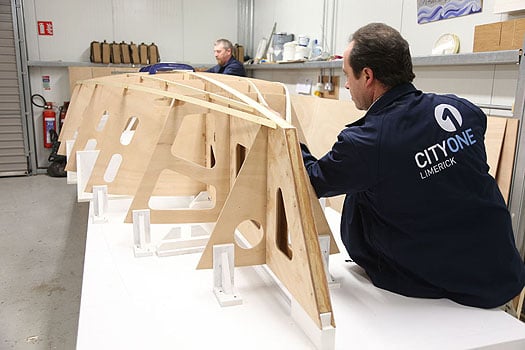Displaying items by tag: Boatbuilding
Irish Boatbuilding Tradition In Arklow Is A Spider’s Web
It’s said that when the experimentally-minded William Petty, the compiler of the Down Survey in Ireland in the 1660s, decided to build his very innovative Simon & Jude catamaran in 1663 for testing in Dublin Bay, the decidedly odd vessel was actually constructed in Arklow. This meant the machine’s debut at Dublin – when she conspicuously outperformed a couple of notably high-performing craft – came as a complete surprise. But if she’d been built in Dublin, it would have become part of the fashionable social round in the city to go and observe the work in progress – an unwelcome distraction.
The success of the original Simon & Jude was replicated to everyone’s satisfaction in Dublin Bay by Hal Sisk in 1991 in a timely reminder that William Petty was a man of many parts. And there’s no doubt that he was also one very smart operator. His land surveys revealed that there was a very choice area in the far southwest of Ireland around a place known as Neidin – The Little Nest – which Petty promptly claimed as his own, and re-named it Kenmare after the Kenmare Bay, as it’s at the head of that inlet.
 A model of the hugely-innovative catamaran Simon & Jude of 1663.
A model of the hugely-innovative catamaran Simon & Jude of 1663.
But while he was at it, he re-named the inlet the Kenmare River. This meant that he now owned all the fishing rights the whole way down to the Atlantic, whereas if it had continued to be officially recorded as Kenmare Bay, he would only have owned the fisheries close along each shore.
 Originally it was called Kenmare Bay, but by ensuring that it was officially re-named (by himself) as the Kenmare River, William Petty secured excusive fisheries rights all the way to the Atlantic
Originally it was called Kenmare Bay, but by ensuring that it was officially re-named (by himself) as the Kenmare River, William Petty secured excusive fisheries rights all the way to the Atlantic
So the fact that he may have used Arklow to have his Simon & Jude built shows that even in the 1660s, when Arklow harbour was little more than the shallow and shifting sandy estuary of the Avoca River, the place already had a notable boat-building tradition that continues to capture the maritime imagination, and manifests itself in a complex spider’s web of weird associations today.
Thus when marine historian and record-keeper Ian Whittaker in Scotland enquired the other day in search of photos and images of some Tyrrell built-boats including the 1954-built 31ft Bermudan sloop Sinloo of Arklow and the 1935-built 35ft gaff yawl Failte II, it sent the linkup wheels spinning.
 The attractively robust Jack Tyrrell-designed and built yawl Failte II of 1935. She was last reported in France some years ago under the name of Tiderip
The attractively robust Jack Tyrrell-designed and built yawl Failte II of 1935. She was last reported in France some years ago under the name of Tiderip
For Sinloo is currently a restoration project of which we hope to carry a more detailed update shortly, while Failte II – an attractively robust vessel built for that noted muscular Christian the Reverend Vandelaur (Kilrush links of course) - was last reported in France under the name of Tiderip.
But once you let connections start to take over, you’re trapped. For although Sinloo was built for the Horsman family of County Wicklow, by the 1960s she was owned by Professor John Kinmonth, and in a cruise of southwest Ireland in 1966, he mentions in his log that between Union Hall and Knightstown, the crew included his schoolboy son Fred.
 Sinloo of Arklow, designed & built by Jack Tyrell in 1953-54, is currently under restoration
Sinloo of Arklow, designed & built by Jack Tyrell in 1953-54, is currently under restoration
That same Fred Kinmonth is now a corporate lawyer in Hong Kong, where he has been noted as the campaigner of some very hot offshore racers called Mandrake. But he has maintained his links to West Cork, and it is he who has commissioned the building of a replica of Conor O’Brien’s world-girdling Saoirse, which - all being well - will be launched by Liam Hegarty and his team from Oldcourt Boatyard for her build Centenary this year.
 Jack Tyrrell’s profile plan of the 1954 Arklow-built Sinloo
Jack Tyrrell’s profile plan of the 1954 Arklow-built Sinloo
And just to close the circle in the meantime, when Conor O’Brien was pressed for the inspiration for the archaic yet effective shape of his design for Saoirse’s hull, he said that it was partially based on a noted fishing ketch of the 1860s which had taken his fancy. That ketch was of course a creation of Tyrrell of Arklow.
 Conor O’Brien’s Saoirse – while largely based on his own ideas, he did admit that he drew some inspiraton from the lines of a renowned Arklow fishing ketch of the 1860s
Conor O’Brien’s Saoirse – while largely based on his own ideas, he did admit that he drew some inspiraton from the lines of a renowned Arklow fishing ketch of the 1860s
Boatbuilding at Ballyholme on Belfast Lough
Betty Amstrong explores past boatbuilding ventures in Ballyholme in the seaside town of Bangor on Belfast Lough.
Did you know that before Enrico Caproni built his famous ‘Palais de Dance’ in 1928 on Seacliff Road that there was a shipyard on that site on the corner of Seaforth Road?
In fact, there were two businesses carrying out shipbuilding and associated work in Ballyholme. In March 1919 Chesney McCormick and Francis J B Connolly together applied for permission to build a ‘Workshop or shed of brick, roofed with slates’ on the west side of Seacliff Road. Connolly was an architect and civil engineer and the 1911 Census shows he lived on Bryansburn Road when he was 23. There are also reports of him being elected as a student member of the Ulster Society of Architects in 1906. In December 1919 McCormick lodged plans for a temporary ‘Boat house and Spar shed’ on Seacliff Road near College Gardens, a terrace part of which became the Ballyholme Hotel.
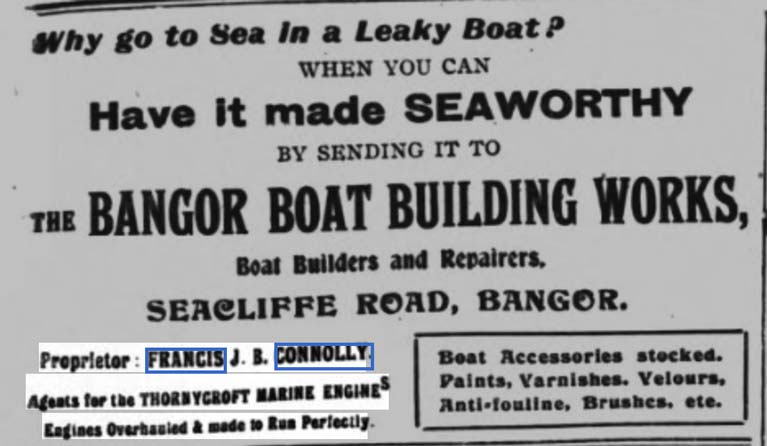 An advertisement from the North Down Herald of 2nd Nov 1920
An advertisement from the North Down Herald of 2nd Nov 1920
In 1920 and 1921 Connolly was advertising under the name Bangor Boat Building Works and in April 1923 McCormick and the Bangor Boat Building Works applied to build a ‘Wooden shop and dwelling’ on the south side of Seaforth Road. The launching slip for the yard was opposite and can still be seen today beside Ballyholme Yacht Club.
 McCormick's Yard in the 1920s
McCormick's Yard in the 1920s
Pictorial records show that McCormick & Co had a shed where Kingsland Nursing Home is today, and this appears to be the location where the Shipyard business carried on into the future. It provided winter storage for the local racing yachts such as Dancers and Rivers and for yachts and motorboats up to 20 tons and built a launching slip opposite. It had a distinctive curve and is still there today. McCormick & Co didn’t last long and on 30th October 1924, the business was advertised for sale. The reason for the demise can be seen in a letter of reference from McCormick & Co in the Public Record Office in respect of a Robert Eddys of Ballymagee Street (High Street) Bangor, which shows that he was an ex-seaman and a rigger and was dismissed owing to shortage of work. The date is 24th October 1924.
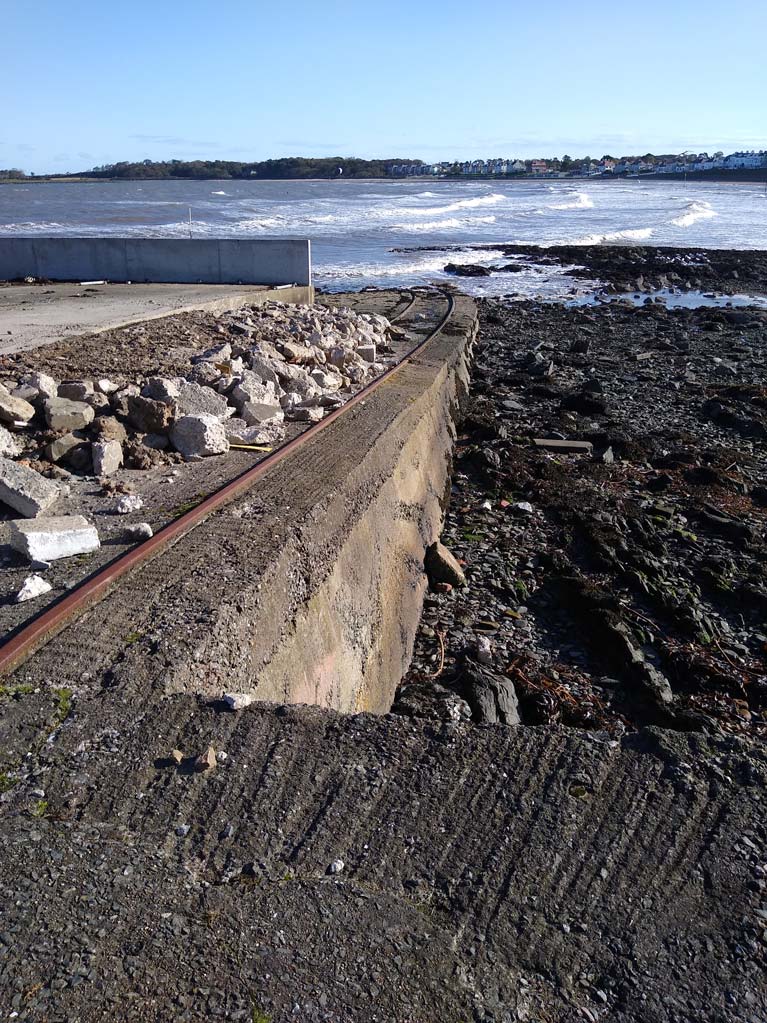 The old slipway at Ballyholme
The old slipway at Ballyholme
Enrico Caproni may have foreseen the demise of the business on the corner of Seaforth Road for in June 1923 he submitted plans for ‘Refreshment Rooms and a temporary shop’. The Bangor Boat Building Works faded from record, but it is known that the slip was transferred to the sailing club at Ballyholme which at the time met in the clubhouse on Kingsland which is now the Table Tennis club. The slip can still be seen today at low tide.
 Lovetts Shipyard Ltd showing Rivers in winter storage
Lovetts Shipyard Ltd showing Rivers in winter storage
The McCormick business was bought by a Mr. W J Lovett, who was one of the Senior Naval Architects and a Director in the Workman Clark & Co shipyard in Belfast. He called the business The Shipyard Company Ltd and in 1925 added a store. By this time Caproni had his café which he called the Mirimar.
In 1926 Mr Lovett asked Robert (Bertie) Slater, a naval architect in Workman Clark’s, to manage the yard. Prior to the liquidation of the company McCormick was building yachts of the Dancing class for Royal Ulster Yacht Club.
The completion of two Dancing Class yachts which had been abandoned was Bertie Slater’s first job. The yard also built ships lifeboats for the Port Line whose liners were being constructed by Workman Clark.
In 1930 the yard built one of the largest boats, a 50 ft passenger-carrying cabin launch for the Lough Erne Boat Co. It made the passage to Belfast under its own power and was then lifted onto a special railway truck and transported to Enniskillen where it was launched into Lower Lough Erne. The shipyard also built six-cabin cruisers for Hyland Ltd and in 1934 a 35ft Motor Yacht, the Moya, for Mr Lovett and to his own design.
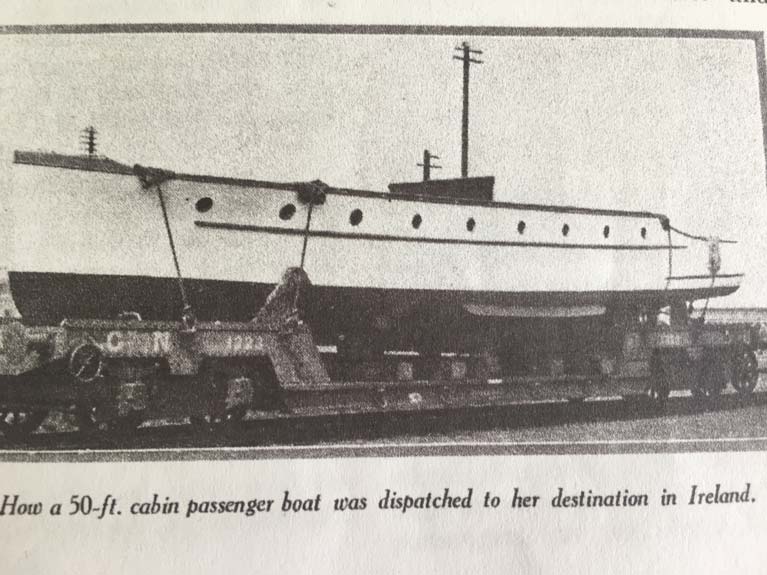 The 50 ft Passenger Launch for Lough Erne
The 50 ft Passenger Launch for Lough Erne
In 1932 Bertie Slater lodged plans for an ‘Iron Shed’. He had married and settled in Ballyholme in 1928 and by 1937 he owned the yard. The late Thirties was a time of slump and little money and the yard struggled to survive. During the war, the yard was very busy with Admiralty work. In addition to maintaining a large fleet of patrol boats and trawlers, the yard built Torpedo Recovery Boats for Lough Neagh. Some of the boats in Bangor had escaped from occupied Norway, Holland, France and Belgium.
Towards the end of the war, Slater built 50-foot-long flat-bottomed Scows for magnetic minesweeping and 36-foot Harbour Launches, some of which were used at Arromanches, one of the D Day beaches. He was also asked by the Admiralty if he could build 112-foot wooden Minesweepers. For this, he identified a suitable site at nearby Groomsport and requested a grant of £10k for a slip, shed, winch and machinery, but was refused. Years later he was told if he had asked for £100k he would have got it!
Slater’s upper yard had a large shed for boat building and repairs. The rest was used for Winter storage and Spring fitting out of yachts and motorboats. The fact that boats could be driven ashore from their moorings in the Bay in onshore gales, provided the yard with extra business for repairs.
Slater subsequently built a sheet metal workshop to cope with Ventilation Trunking for mills and factories. The shipyard installed the ventilation ducting in The Tonic Cinema in the late Thirties. A second building shed was constructed alongside the original shed to cope with RNLI repairs and maintenance.
After the war Slater designed the S Class cruiser, a superb affordable sailing yacht built in the traditional way by skilled craftsmen. The S-class boats are sturdy cruisers, well suited to Irish and Scottish waters. Many of these yachts are still sailing today.
In 1958 Bruce Cowley, who had retired from HMRC, bought the yard. Cowley continued the S Class production, making a total of 22 built in Bangor between 1946 and 1964. He also built well-known large cruising yachts; Jaynor for Ivan Selig built with the Fastnet race in mind, the famous Duncrue for Sean McNeill, and Trasna of Ely for the Duke of Westminster on Lough Erne.
In 1969 the yard was in receivership and Frank Smyth, who at this time owned a small boatyard in Donaghadee and a chandlery in Bangor, bought the business and for a time traded as Bangor Yacht Supply Co. In 1975 it became Bangor Shipyard Ltd. When Frank started the workshop had an earthen floor and very old equipment which he replaced with gear from the Donaghadee workshop.
His venture into boat building began with three small wooden punts and then with the introduction of fibreglass, Smyth made his own small dinghy moulds and began producing them. He subsequently shipped in fibreglass hulls from England and fitted them out. These he sold in the small chandlery in Bangor. The first big job in the Shipyard was repairing Velia for the well-known hotelier, George Ralston and the yard was also recognized for the repair of the Donaghadee, Aranmore, Cloughey and Portrush lifeboats. The lifeboat work was suspended by the RNLI for fear of terrorist action (this was during the Troubles) but Smyth grasped the opportunity and obtained the contract for repairing two pilot boats from Carrickfergus which were damaged by an explosion.
Up until this time Smyth had to lay rails in sections on the road on which to make the transfer from the yard to the slip, which took at least an hour. Frank approached the then Town Surveyor, Martin Gray, who persuaded the Council to allow rails to be embedded in concrete in the road to make the movement smoother and easier. On one notable occasion, the Seacliff Road had been blocked when the concrete rail bedding collapsed due to the fishplates not having been fitted properly!
Another improvement resulted from the purchase of a secondhand winch (which was to have been scrapped) from the Belfast aerospace company Short Bros for £25 and an ex RAF tractor bought in an auction for £100. Frank also acquired a hydraulic crane and for several years, Fred, the crane driver was in demand across the country for lifting boats.
Building and repairing fishing boats formed a substantial part of the business. This developed into a full-blown boat building business with a sizeable workforce. Many of the names will be familiar to seafarers – Elias Scott (Scottie) who was awarded a BEM, Willie Harvey, Ken Bewley, Jimmy Hamilton and Norman Henry. Government grants for fishing boats made the financial situation easier and this part of the yard flourished for about ten years. At this point Smyth was building larger fishing boats of 70 feet in length and to accommodate these he demolished the old shed and built a larger one. The maintenance and refurbishment of RNLI lifeboats also formed a large part of the business.
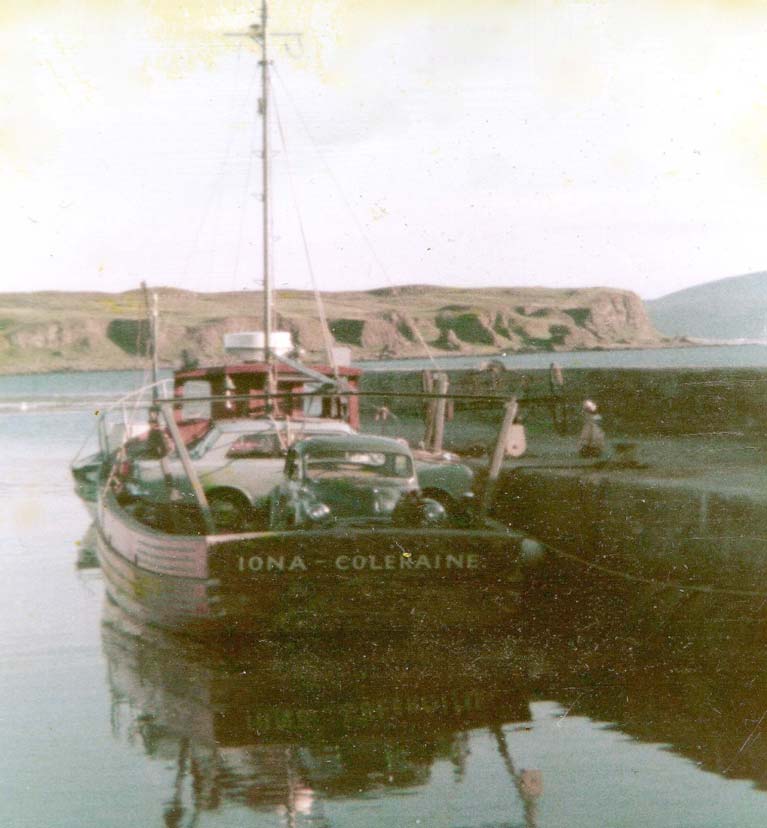 Iona car, cattle and caravan transporter
Iona car, cattle and caravan transporter
Among the many fishing boats Smyth fitted out was the 30-ton Ros Mor for local fisherman, the late Jack Miller. The Fragrant Cloud, Xmas Star and the Jubilee Star, the Sarna and the Iona were other craft among many. The latter was built for Tommy Cecil of Rathlin. It was the first fully decked ferry boat built for trade between Ballycastle and Rathlin. Subsequently, to Frank’s surprise, Tommy asked for the decks to be strengthened. It turned out he was carrying cattle, cars and caravans!
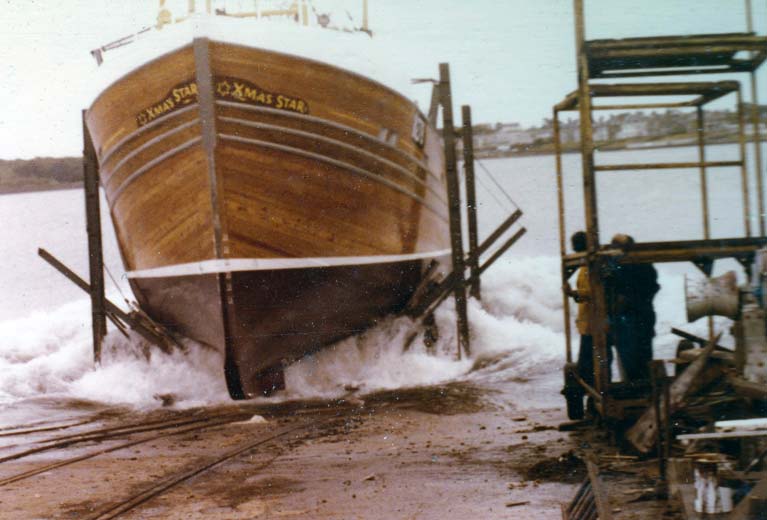 Launch of Xmas Star
Launch of Xmas Star
By this time the Government had built sophisticated slips at Kilkeel and Portavogie, wooden construction was diminishing, and grants were cut, all making boatbuilding difficult. Then came Bangor Marina. Smyth was invited to tender for the Bangor boatyard contract, but for him this was unworkable and as boatbuilding at Ballyholme was no longer viable and the yard closed in 1991.
The author acknowledges the help in gathering this information of Ronnie Slater, son of one of the owners and Frank Smyth, the last owner of the yard. Also, of Leanne Briggs of North Down Museum, and of the Public Record Office
Green Marine, UK Performance Yacht Builder, Goes Into Liquidation
#TradeNews - BBC News reports that Green Marine, the high performance yacht builder in the UK responsible for entries in the Volvo Ocean Race and America’s Cup, has gone into liquidation.
Forty-six jobs have been lost with the end of trading at the boatbuilder, which moved its core business to Hythe in Hampshire from Lymington and Southampton in recent years in order to take on multiple projects.
A slowdown in large yacht orders has been blamed for the decision to enter voluntary liquidation — though a Scuttlebutt Europe reader alleges manoeuvres at the builder’s Dutch owners Vitters undermined its ability to prosper.
Green Marine build more than 180 boats since it was founded in 1982, specialising in custom racing yachts such as those competing in the Volvo Ocean Race, the Vendée Globe, and Sir Ben Ainslie’s recent America’s Cup challenge.
BBC News has more on the story HERE.
Pat Lake RIP
The death has occurred unexpectedly in Cork of one of the most respected figures in boat building in Pat Lake, who led Castlepoint Boatyard in Crosshaven for many years before his retirement a decade ago.
Pat had been a major figure in boat building and the maritime scene. His record includes many achievements, not least of which was his involvement in the building of the leather boat at Crosshaven Boatyard for the famous St Brendan recreation voyage in 1976.
Pat Lake died at St Finbarr’s Hospital in Cork. He is reposing at Forde’s Funeral Home, Old Waterpark, Carrigaline. Removal tomorrow (Sunday 17 September) at 5pm to St Brigid’s Church, Crosshaven. Requiem Mass on Monday (18 September) at 11.30am; funeral afterward to St Patrick’s Cemetery.
Ireland's Invisible Boat Builders
#boatbuilders – In the good old days of bespoke boat-building, regular visits to the boatyard by the prospective owners were a sociable part of the process, regarded as normal and mutually instructive. And as most boats were built in waterfront premises beside slipways, or at the very least on a quayside, the first immersion was much more than just an informal splash from a convenient travel-hoist or a crane. On the contrary, it was the Launching Ceremony, a carefully choreographed festive event complete with the breaking of a bottle and sometimes even including the proper blessing of the new boat.
But nowadays, while such events can to some extent be staged, inevitably they have a certain artificiality. With transportation vehicles and roads improved out of all recognition, most production boats are now being built in factories at some distance from the sea - waterfront property is much too valuable to be used for basic industrial purposes.
As for seeing "your" boat being factory-built, you have to be up towards the top of the product range to be allowed that, and even then you mustn't bother the builders by talking to them. So the "launching" is simply a practical task carried out by professional marina staff with a minimum of fuss, for it has always been the case that when you just want to get on with a launching in a businesslike way, the last person you need around the place is the fretful owner.
Thus today's marine industry aspires to be the waterfront version of the car trade. Smooth, clean and impressive premises. Ready-to-go immaculate vehicles. And no hint at all of the need to get deep down and dirty in the building and maintenance of boats. But not every sailing and boat enthusiast is content with accepting such production-line techniques. W M Nixon takes a look at some of Ireland's invisible boat builders who cater for those owners who are different, and sometimes are doing it entirely for themselves. He also reveals the revolutionary Clontarf Contrivance, a Boon for Boatbuilders in classic style.
There are two Gods in the pantheon of Ireland's invisible boat-builders. One is Jimmy Furey, who creates exquisite classic clinker-built beauties to order in his tiny workshop in County Roscommon near the west shore of Lough Ree. And the other is Roy Dickson, who is incapable of sailing any boat without thinking of some way he'd like to improve it, and was a pioneer of the DIY dinghy-building movement in Ireland a very long time ago.
They're the Gods of our pantheon as both are now well into their eighties, and their influence has spread far beyond the shores of Ireland despite the fact that both are unassuming men who like nothing better than quietly getting on with the job.
But while Jimmy Furey is part of a long and distinguished Shannon tradition in that his innate talents emerged from working with his boat-builder brother Paddy, and are in turn being passed on to other master craftsmen such as Dougal MacMahon of Belmont on the western stretches of the Grand Canal, Roy Dickson is a complete one-off who is an inspiration to many, but you couldn't really say that there is a Roy Dickson School of Boat Re-Configuration.
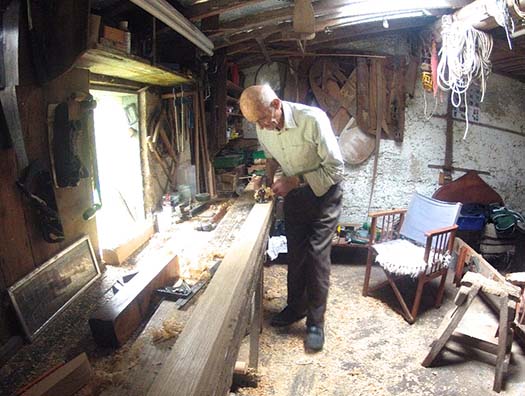
Jimmy Furey quietly in action in his remote workshop in County Roscommon on the west shore of Lough Ree. Photo: Cathy McAleavey
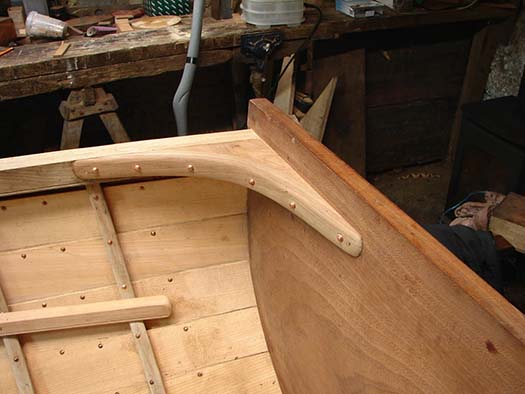
The detail is a joy to behold. One of the transom knees in a Jimmy Furey Water Wag. Photo: Cathy McAleavey
The joy of Jimmy Furey's work is in the detail, so it's no surprise to learn that he turns his hand from time to time to being an award-winning model maker. But the beauty of his boats, whether they be Shannon One Designs or Water Wags, is of such a high order that you could say they're of international classic model boat standard while happening to be full size boats which can give a good account of themselves on the race course.
There is only so much work that any one man, however talented, can do, so it's encouraging to know that Dougal MacMahon is following the Furey way, his most recent job being restoration work with new planks and gunwhale, and re-installation of the centreplate casing, in Ian & Judith Malcolm's hundred-year-old Dublin Bay Water Wag in order for the boat to be fit to take part in next month's massive migration of the Wags to the big Morbihan festival in south Brittany. There, they will link up for the first time with the new French-built Water Wag, the product of Skol ar Mor which has been bought by Adam Winkelmann of Dun Laoghaire.
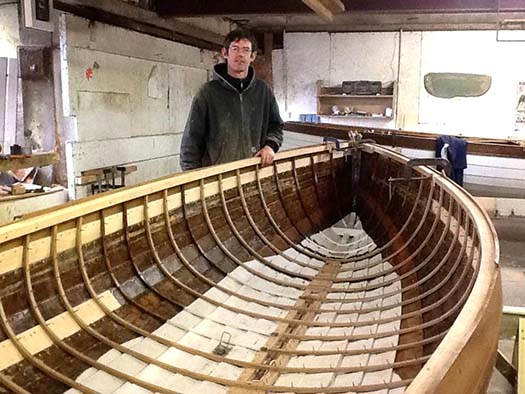
Dougal MacMahon of Belmont in County Offaly at the midway stage of this month's project to put a hundred-year-old Water Wag back into full health. Photo: Ian Malcolm
Having been looking at the new work on the Malcolms' Centenarian Barbara yesterday morning, rest assured that the Levinge/Furey style and quality is being upheld by Dougal MacMahon. Any good clinker-built racing boat will have a certain suppleness – indeed, it's said that one of the skinny Shannon One Designs will turn round and look at you when being driven to the utmost in a hard breeze. But with the Barbara, suppleness had deteriorated into sogginess. Yet less than two weeks of very concentrated work down in Belmont, with Dougal MacMahon as the master craftsman and Ian Malcolm as the gofer, has transformed the boat - there's new life in Barbara.
These days, Roy Dickson of Sutton is the doyen of boat building and modification through the use of modern materials. But as a recent celebratory lunch organized by his many shipmates past and present in Howth YC reminded us, in his astonishingly long career he did his duty and more by wood before bringing in various modern exotics. In fact, he started around 1950 with a Snipe called Bambi sailing out of the now defunct Kilbarrack SC on the north shore of Dublin Bay, whose demise began with its sailing waters inside the Bull Island being divided and made prone to silting by the construction of the fixed causeway across to the middle of the island.
Until that happened, KSC had a wonderful sheltered sailing area towards high water, as they'd a huge saltwater lake all the way to the Wooden Bridge. So they could get sailing even when conditions in Dublin Bay ruled out sailing at Sutton Dinghy Club itself. But soon enough, the young Roy Dickson had himself moved to Sutton, where he was Commodore in 1954, and he'd changed boats, building himself two Jack Holt-designed 16ft Yachting World Hornets – complete with International Canoe-style sliding seats for the crew - between 1954 and 1959, and racing them with success.
But as the best racing in Sutton was in the IDRA 14s, he built himself one of them in 1960, and then in 1961 he and Bunny Conn were in the forefront of the introduction of the Enterprise class, so that was his next command.
However, it wasn't until 1963 that all the Dickson stars came into alignment – the Fireball appeared. He was in there from the start – his first Fireball was No 38 – and with the class's flexible measurement system, the Dickson imperative for innovation had free range. And what he did was noticed by others. It's said that in his dozen or so years with the Fireballs, if some mod he made to his boat of the day proved beneficial, it would be done on every boat in Ireland within a week, and on every competitive boat in the world within a month.
As for Roy's sailing, he was competitive right up to world level, doing an early Fireball worlds in America with success with a youthful David Lovegrove, now President of the Irish Sailing Association, on the wire, with another Worlds in the Lebanon – God be with the days when you'd think of having a world sailing championship there – seeing one Bob Fisher as Roy's wireman.
Eventually, the Dickson campaigning moved into offshore racing with a succession of boats which, when combined with the possibilities provided by a variety of measurement rules, provided the artist with an enormous canvas to work with, and he was busy for decades. Most recently he has been best known for his stellar campaigns with the Corby 40 Cracklin Rosie and the Corby 36 Rosie, but we have to remember that by the time the boats left Roy's ownership, they were hugely different from the plans presented by John Corby.
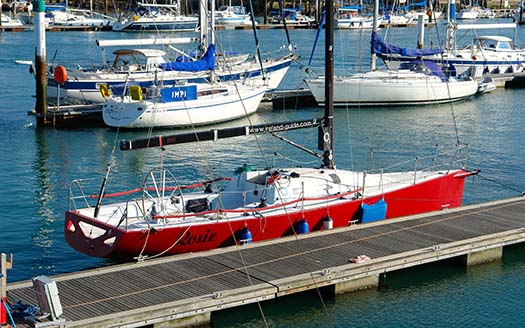
The Corby 36 Rosie was the last boat to be campaigned offshore by Roy Dickson in a remarkable career which has included several Fastnets and Round Ireland races in addition to success in Cork, on the Irish Sea, and in the Clyde. He now races the Corby 25 Rosie in club events. Photo: Brian Mathews
Each winter, the boats would be trailed back to a special spot beside Roy's house, and unless you were in constant attendance you'd no idea of just how much tweaking and surgery was taking place. He brings his brilliant engineer's brain to the challenges of boat performance enhancement, and many are the specialists who experienced that special thrill of anticipation when they got a Monday morning phone call from Roy which simply opened with the statement: "I've got an idea".
For as sure as God made little apples, an utterly fascinating project would follow, and even if it involved hours of brutal hard work by volunteers – such as the shifting of the weight configuration in the keel-bulb on Cracklin Rosie – well, Roy is the kind of leader who inspires people to loyal service way over and above the call of duty.
These days at age 83, Roy's sailing wings are slightly trimmed as he campaigns his Corby 25 Rosie in club events, but the mark he made in sailing inevitably makes you wonder if there's any modern equivalent to the innovations of Roy Dickson in his prime, and your only conclusion can be that the modern version would have to be a marine industry professional. And at the sharp end of Irish sailing development, there's no doubt that Chris Allen of Bray is the man to go to if you want thinking and work way outside the normal box.
Yet though he works with completely state-of-the-art composites, Chris is in the finest tradition of the invisible boat-builder. Bray may be a seaside town, but his workshop is well away from the harbour, in fact it's alongside a rather pleasant little residential development in the heart of Bray beside the River Dargle. But the workshop itself is a decidedly basic and utilitarian sort of place where the space is shared with a car restorer, and as the car-fixer works with a giant oven while Chris works with a small one in order to achieve the temperatures their composites require to cure, the fact that the shed was freezing – and that on a sunny April day – was neither here nor there.

Graeme Grant and Chris Allen, the hidden boat-builders of Bray. Photo: W M Nixon
Chris's current project – on which he's working with Graeme Grant, Irish boat–building's favourite Scotsman – is building the very latest in the International Moths, complete with foils and a proven speed potential for normally competent dinghy sailors of thirty knots, while the sky's the limit speed-wise if you're a true ace.
{youtube}QlAzBoXy6g8{/youtube}
They've the tiny hulls and decks ready to go, but are being held up on completion by the late arrival of special components from various manufacturers. Meanwhile, they're busy with refining ever further the moulding of the struts which support the whole crazy caboodle of trampoline and rig and daggerplate and rudder and foil control, which means they're utterly absorbed in the sort of time-consuming task which would give any formal company financial controller the heeby jeebies.

The carbon hull of a Chris Allen Moth is exceptionally light........Photo: W M Nixon

.....and we mean REALLY light. Photo: W M Nixon

Chris Allen with moulds for the ultra-light struts for the International Moth. Photo: W M Nixon
But then Chris Allen's career path is scarcely along orthodox lines. He started his sailing on Lough Muckno in northeast Monaghan where his father – Dun Laoghaire sailor Hugh Allen, who had crewed with Alf Delany in the two-handed Swallow Class in the 1948 Olympics – had been posted as the Bank Manager in Castleblaney. Hugh Allen wasn't going to let the little dark hills of Monaghan end his sailing, so he built a Mirror and founded the White Island Sailing Club to race on the local lake, as he rightly reckoned that a Lough Muckno Yacht Club wouldn't quite do the business.
Subsequently he was posted to Moville in Donegal, and by this time he'd moved up to GP 14s, so we could argue that the current pre-eminence of Moville in Irish GP 14 racing goes right back to a former Olympic sailor being in the town. And it goes further than that, as the Allens' GP 14 was subsequently sold to a rising star in Dundalk sailing, one Pat Murphy......
Meanwhile, like many another young fellow, Chris Allen gave up sailing for ten years from the age of 18. He was into the music business, which isn't a sports-friendly way of life. But by the age of 28, sailing had hauled him back in again by way of Bray Sailing Club, and he was soon bring technical expertise to boats. Somehow or other, he ended up in New Zealand, and while his musical abilities were useful, his primary occupation was working with the innovative boatbuilder Cookson's, whose many successful creations have included Ireland's 2007 Fastnet Race winner Chieftain (Ger O'Rourke), a canting keel Farr 50.
For high tech boatbuilders, a spell working with Cookson's is the equivalent of a Harvard MBA for anyone who wants to rise in the corporate executive officer ladder. But back in Ireland, the corporate world is slightly more developed than the marine industry, and in hoping to use his skills honed in New Zealand, Chris Allen found he was building the hugely successful Velvet Glove for Colm Barrington in a shed in Enniskerry, and then when he came to build the arguably even more successful Ker 32 Voodoo Chile for Eamonn Crosbie, he'd found his current hidden premises in Bray.
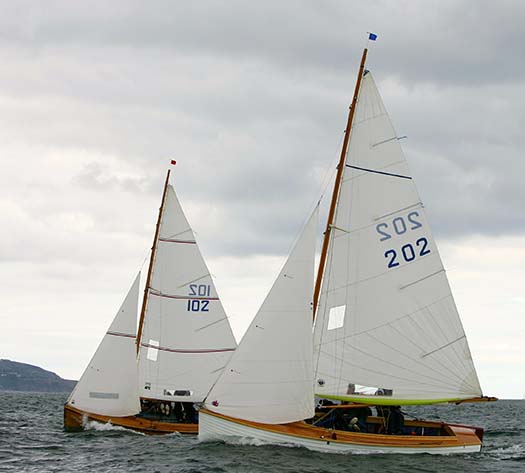
The glassfibre Mermaid Dolly (right) was a lovely piece of work by Chris Allen, but in the end the class decided to stay with timber construction.
His enthusiasm remains undimmed, as too does his readiness to express firmly-held opinions on boat-building of all kinds. But his skill in his specialist area is unrivalled, and he can be as versatile as any boatbuilder. Thus he was the man to go to in the days when the SB3 – then in its first incarnation as the SB20 – was experiencing a certain amount of teething problems. But equally, when Roger Bannon wanted to experiment with a GRP version of the Mermaid, he quite rightly reckoned that Chris Allen was the man to go to, and the result was one of the sweetest clinker GRP boats you'll ever see, even if the class in its wisdom decided eventually to stick doggedly with wood.
As we were in Bray, there'd been a hope of going on to see the two new Bray Droleens as they near completion, but in this case the invisible boat-building remained utterly invisible. The project is currently on hold while the workshop undergoes a renovation project, and the pair of little boats are temporarily in store in a shed whose key-keeper happened to be in the other end of County Wicklow. But nevertheless it's good to know that Anthony Finnegan and his team have continued the fine work started by the late Frank de Groot, and congratulations to Jim Horgan of Furbo on the south Galway coast, whose re-creation of a Droleen was recently awarded one of the Classic Boat Trophies in London.

Jim Horgan sailing his award-winning Bray Droleen in Connemara
It was far from the world of classic boats that the next item on our North Wicklow agenda lay, as we were working on the ancient Chinese principle that seeing something once is worth hearing about it a hundred times, and we were determined to see for ourselves if the new multi-functional maritime clubhouse really is being built beside the re-developed harbour and marina in Greystones.
So, having been immersed for the morning in the hidden marine industry, that afternoon we had the modern marine industry in its most visible form. For although the new clubhouse is as yet barely above ground, it is definitely being built. And nearby at the marina, James Kirwan and the team in BJ Marine were in hospitable form on a perfect sunny day with a steady stream of seriously interested visitors coming to see fully finished yachts in showroom condition. It was like a different planet, and we much enjoyed a conducted tour of a spanking new Oceanis 38 which has been prepared and laid out for a Dun Laoghaire owner who is quite clear in his own mind that he only intends to use the boat for day-sailing and hospitality purposes.
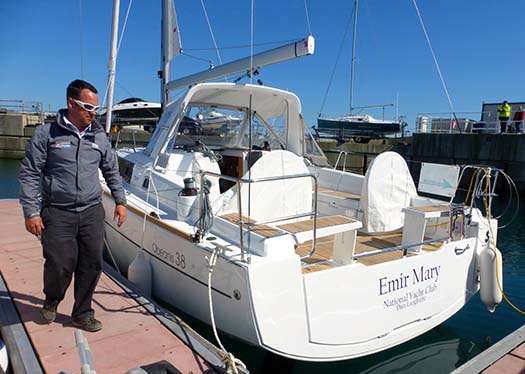
The way we live now.....James Kirwan of BJ Marine with a new ready-to-go Oceanis 38 in Greystones Marina. Photo: W M Nixon
Believe me, with the sun shining down and James Kirwan enthusing about the success of the new BJ Marine linkup to the Snowdonia Riviera on Tremadoc Bay with their latest office in Pwllheli in North Wales, you could be very easily seduced into availing of all the ready accessibility of today's front-line marine industry if you just happen to have the magic ingredient of enough money. But for most of us still spluttering our way out of the deluge which was the recession, it's a matter of making do as best we can.
And for others, the shiny new boats are not the way to go at all. On the contrary, they want to experience traditional hands-on lovingly crafted boat-building for personal fulfillment as much as having a boat at the end of it, and out the back of Clontarf Yacht & Boat Club there's a kind of Men's Shed operation convened by Ronan Melling which has been building a classic IDRA 14 for quite some time now, but the results show that they're willing to learn, and nothing is too much trouble to achieve perfection.

And now the tricky bit.....a spot of concentrated thinking under way last November as the Clontarf team grapple with the challenge of steaming and installing the frames in their new IDRA 14. Photo: W M Nixon
It's also the very essence of the invisible boat-building spirit, as they're only in action on specific nights for work spells of set duration. But on a first visit last November when you could already see that the planking work was of the highest quality, they'd got to the crucial stage of putting in the first steamed frame, which with all the hassle of keeping a steamer up to heat, is quite a step for an amateur team.
But they persevered despite having problems with several types of steam boxes, and then somebody had the wonderful idea for the Clontarf Contrivance. Somehow they made the leap from thinking how steaming a frame is a matter of keeping up pressure to the notion that a bicycle tyre is also a matter of keeping up pressure. The inner tube from a bicycle tyre, with a bit of another inner tube added for the required length, will neatly accommodate the complete frame for an IDRA 14. All you need to do is put the steam into it under the optimum amount of pressure. It has worked, for as the most recent photos show, the task so tentatively begun last November is now complete with as neat a framing jib as you could hope for.
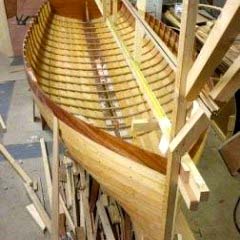
As neat a job as you could wish. The new IDRA 14 with the frames in place.

The secret weapon. We all know what a bicyle inner tube looks like, but have you ever thought of it as the Clontarf Contrivance for steaming frames for clinker-built boats?
The spirit of doing it for yourself is if anything even stronger along Ireland's western seaboard, and back in SailSat for the 29th March 2014 we featured – among many other boats – the Atkins schooner which the great Jarlath Cunnane was building for himself in Mayo in anticipation of the eventual sale of his Arctic Circle-girdling Northabout.
Well, Northabout has now been sold and will be going to the Antarctic as an expedition boat, but meanwhile last Autumn I grabbed a quick photo of the new schooner finally out of the building shed (which for once actually is a waterside shed), and we look forward to seeing her afloat and in action.

Shaping up nicely. Jarlath Cunnnane's new alloy-built schooner. Photo: W M Nixon
Far to the south along the Atlantic seaboard, and up the winding Ilen River above Baltimore you'll find Oldcourt and the Old Corn Store where the restoration of the Conor O'Brien ketch Ilen is moving steadily along. But as the Ilen project is ultimately Limerick based, the fine premises in Limerick where Gary MacMahon and his team built both the traditional gandelows and the CityOne dinghies provides an excellent workshop for building the more detailed parts of Ilen, and this week Gary circulated a photo of the deckhouse which will go above the engine room, and very well it looks too.

Ilen's new engine room deckhouse, workshop-built in Limerick. Photo: Gary MacMahon
For in winter, there is nothing more conducive to getting jobs completed than having adequate resources and a clean and comfortable workshop where you've a bit of space to go about the project, which so often is not the case for Ireland's hidden boat-builders.
But they do things differently in other places. Back in SailSat of February 7th this year, we ran a piece which included news about a restoration project which is under way with a specialist company in Palma in Mallorca, giving new life to the 37ft Fife-designed Belfast Lough One Design Tern of 1897 vintage. We published a photo of Tern as she was in July 2014, striped off and ready for the work. On Thursday, I received two photos of Tern being launched on Wednesday after nine months work. Just to show what has been achieved, we start with that photo of Tern in July 2014. Further comment is superfluous.

Tern as she was in July 2014.
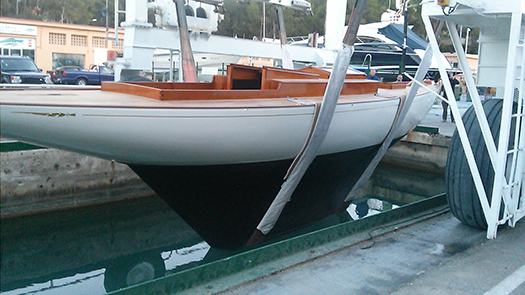
Tern as she was last Wednesday, test launching in Palma.

Work of the ultimate quality. Tern's new bronze deck fittings are probably worth more than the boat herself was when she was built to a fairly basic specification by John Hilditch of Carrickfergus in 1897.
#OnTV - A boatbuilding project on the shores of Lough Ree will feature in a segment of tonight's Nationwide on RTÉ One from 7pm.
The 'Mens Shed' scheme for the Lanesborough-Ballyleague area – as part of a job activation and family support initiative for the twin towns – brought together 14 men to learn the craft of boatbuilding.
And the results are more than impressive, with the team building four new boats in just 25 days – a "huge success" in the words of Ballyleague-Lanesborough Area Mens Shed chairman Joe Cribbin
He hailed the scheme as preserving traditional arts and crafts for a new generation.
"On this occasion, as the lads continue their voluntary work in painting the boats, we would like to thank each and every person who supported this project in any way.
"Our special thanks to Anthony Dockery of Roscommon Integrated Development Company and Bernie Morris of the Department of Social Protection, Ted and Sheila Falvey, Lanesborough Community College and Waterways Ireland."
Cribbin added that it's hoped two of the new boats will be ready to be blessed and launched by the June Bank Holiday weekend – Sunday 31 May at 2pm at the Ballyleague Waterways Ireland harbour slipway.
Link to the programme HERE.
The Irish Heart is Still in Wooden Boats
#woodenboat – Wood used to be the material of choice for boat-building. But it has long since been superseded by glassfibre and other variations of plastic, while aluminium – for more than two centuries the "metal of the future" - is now widely accepted for small boats which get rough usage but little maintenance. Yet wood still talks to us. It's part of what we are. W M Nixon takes a look at some current Irish wooden boat-building projects.
It's one of the most natural things in the world to feel an affinity for wood, and enjoy working with it. It's right there in our DNA. Back in the mists of time, when early man was emerging from a primitive wandering existence, the ability to make fires and tools and weapons with wood, and even better the ability to create a shelter from wood when no cave was available, could make all the difference between life and death.
Those early humans who saw wood as something beyond the means merely to make a fire had a superior inbuilt survival mechanism. This in time evolved as an instinctive fondness for wood, a positive emotional response to working with it. Even nowadays, when we live in a world dominated by synthesised materials and mass-produced objects, simply going into a traditional woodworking shop or boat-building shed triggers a favourable atavistic response. We feel comfortable. We love to run our hands along the timber, and savour its aroma. Our heads may tell us that plastic and metal work better for many regularly-used objects, but our hearts are still in love with wood.
Any boat-building project in Ireland will always attract a level of interest way beyond the size of the boats involved if the boat is being built in timber. Don't get me wrong, though. Glassfibre is undoubtedly a wonderful boat-building material which – uniquely – is created as the boat is being built. And I've been using a lot of it in the epoxy version in my own boat's re-configuration project. But while you appreciate its excellence intellectually, there are very few people who respond with favourable emotions to the sticky business of working with it, which is something best done as clinically and cleanly and quickly as possible.
Pure working with wood, on the other hand, is just so comfortable, so reassuring. You can happily linger over it. You never find yourself wondering if this is what nature intends you should be doing. On the contrary, in working with wood, we fulfil a natural imperative. And little wooden boats of traditional shape are a special joy.
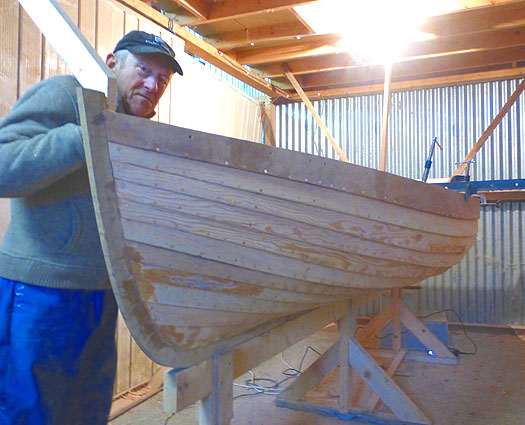
Larry Archer, best known as one of Ireland's leading glassfibre boat-building pioneers, has particularly enjoyed returning to his earlier skills as a classic wooden boatbuilder in re-creating the Asgard dinghy Photo: W M Nixon
Not least of their special joys is that, as we emerge from recession, building a small wooden boat has all the pleasures of traditional boat-building, yet with manageable expense. Thus a classic ten foot clinker dinghy perfectly fits the bill in these straitened times. And as she has the impeccable pedigree of being to a design by the great Colin Archer of Norway, the excellent value for money is beyond dispute as this little boat nears completion in a hidden shed in the depths of Fingal.
But the actual working with wood can be every bit as important as the classic or modern nature of the design, and equally intriguing is the City One project in Limerick. There, people who otherwise mightn't get a chance to build a boat, let alone sail one, are much involved with building modern dinghies to a design by Theo Rye. This is being done in a project under the Ilen umbrella, the Ilen being the Conor O'Brien ketch of 1927 which the Ilen Trust is restoring with trainee shipwrights.
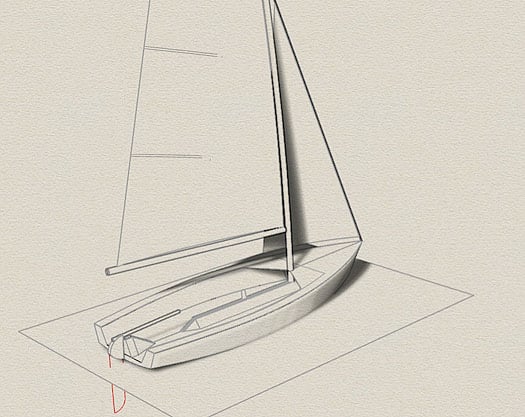
The new City One performance dinghy for Limerick has been designed by Theo Rye.
Over on the East Coast, a boat with distinctive neighbourhood sailing connections can provide a very tangible focal point where a sense of place is sometimes difficult to discern in the region's increasing urbanisation. In Bray, they're reviving that seaside town's local sailing traditions by building new boats to the 12ft Droleen design, which was designed specifically for Bray small boat enthusiasts by local sailing man W Ogilvy way back in 1897.
Ogilvy's original designs had faded, so quite some time ago the Bray people got the late O'Brien Kennedy to re-create them, and the result is such an attractive and able twelve footer that they've not only built the first new one to acclamation in Bray, but across in Spiddal on the Galway coast that renowned boat-builder Jim Horgan of Galway Boatbuilding School – who has created an astonishing total of 200 wooden boats in his time – has built another Droleen for general use in Connemara. It has proven "such a neat little boat", as he so aptly puts it, that another is likely in the near future.

"A neat little boat". The community-built Droleen nearing completion in Bray. The classic design has also been successfully used for a small workboat in Connemara
The Asgard dinghy is a replica of the little boat which Colin Archer designed and built in 1905 for Erskine and Molly Childers to be the tender for the newly-married couple's wedding present from her father, the 51ft ketch Asgard which became part of Irish history with the Howth gun-running for the Volunteers in July 1914.
Asgard is now conserved, and is the centrepiece of a simple yet very effective display in the Collins Barracks museum in Dublin. But as John Kearon and his team neared the completion of their excellent conservation project, the economic recession struck home, and it became clear that Government funds would not run to fitting any sort of rig to the boat.
However, a new squad of Volunteers emerged from a wide variety of sailing backgrounds in the hope of putting some kind of rig in place in order to give a better idea of what Asgard looked like in her prime, using spars which included the original mainboom. There was no stopping this team, which is not surprising when you consider it included global circumnavigator and former dinghy champion Pat Murphy, Arctic explorer and voyager Paddy Barry, long distance solo sailor Mike Alexander, multiple inshore and offshore sailing champion Neville Maguire, and intrepid sailor/boatbuilder Wally McGuirk and his son Rory.
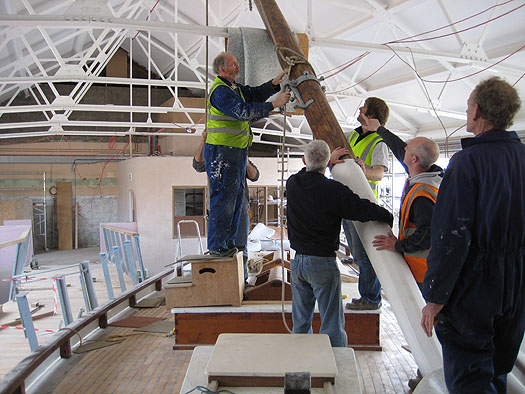
The "new Asgard volunteers" stepping the mast in Collins Barracks. Photo: Neville Maguire

Even though the rig height is very limited by a shortage of headroom, Asgard as she is now displayed looks much better for having something which shows how she appeared when fully rigged. Photo: W M Nixon
Thanks to their work, despite the limited headroom in the Asgard Museum we now have a much better idea of how this wonderful vessel looked in her prime. But as she is so permanently installed as a national monument in Collins Barracks, there's no way she's going to be readily moved for anything, not even the Centenary of the Howth Gun-Running on July 26th this year. So the new Volunteers began to think of building a replica of the Asgard dinghy, whose basic plans were discovered by John Kearon in the Colin Archer archives in the Norwegian Maritime Museum in Oslo.

Sketch plan of the proposed 10ft dinghy for Asgard as drawn by Colin Archer in 1905. Courtesy John Kearon
Though they'd made a fine job of Asgard's shortened display rig, they didn't see themselves as qualified boatbuilders for the detailed construction of a classic little clinker dinghy. But fortunately Fingal boatbuilder Larry Archer – and no, he's not Colin Archer's great-grandson as some have surmised – has the necessary traditional skills in abundance, even if he is noted as one of the pioneers of glassfibre boat-building in Ireland.
In fact, Larry is the classic illustration of my point that much as we acknowledge the sheer good sense of quality boat-building in fibreglass, there is still nothing so profoundly satisfying as traditional boat-building in wood. So he agreed to build a replica of the Asgard dinghy in a manageable budget, and as the boat nears completion, Pat Murphy has raised the money from Asgard well-wishers, and businesses in the Howth area.
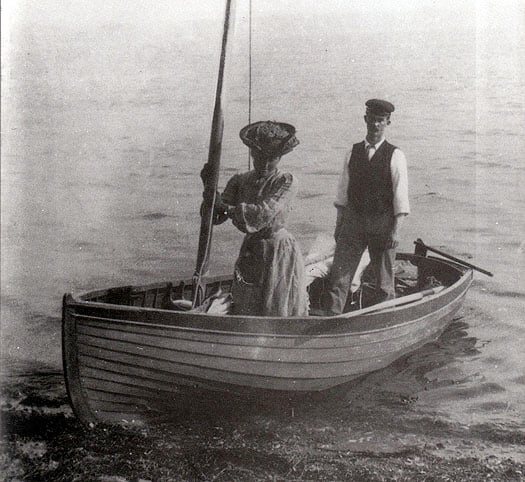
Molly and Erskine Childers with Asgard's dinghy

Asgard as seen from the dinghy during a cruise around 1910 Photo courtesy TCD.
But aside from the historical significance, like the Asgard herself this little boat has a significance all of her own. Nowadays, with the ready availability of inflatables and small RIBS to act as safe cruising yacht tenders which can be stowed on deck, we've forgotten that in times past, cruising people had to make do with dangerously small rigid boats for tenders if they wished to stow them on deck. And if they wanted a high level of safety in their tender, they had to be prepared to tow it.
In fact, in the 1930s, the Clyde Cruising Club had a rule that yachts racing in their annual Crinan to Tobermory Race, which marked the start of the traditional Glasgow Fair fortnight's holiday in July, were obliged to tow their dinghies. Much effort therefore went into designing dinghies which were safe yet sweet of line, and we've a classic photo of the great John B Kearney's 38ft yawl Mavis from Dublin Bay coming in to Tobermory in 1938 after winning the race from Crinan with the little dinghy under tow the whole way.
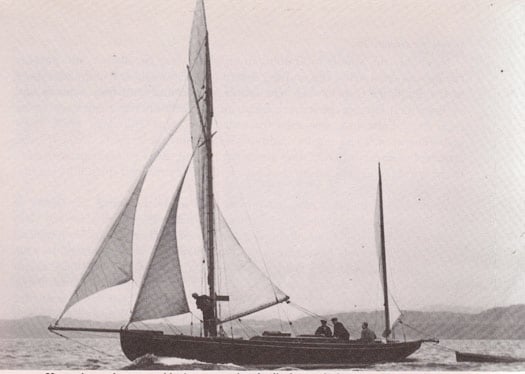
John Kearney's Mavis coming into Tobermory Bay in 1938 after winning the CCC race from Crinan, and towing the dinghy as required by club rules.
There's a direct link to the team connected with today's building of the Asgard dinghy, as the next photo we have is of Neville Maguire in his schoolboy short trousers rowing the Mavis dinghy in to the pier at Schull after placing second in the Irish Cruising Club's 1945 race from Crosshaven round the Fastnet.
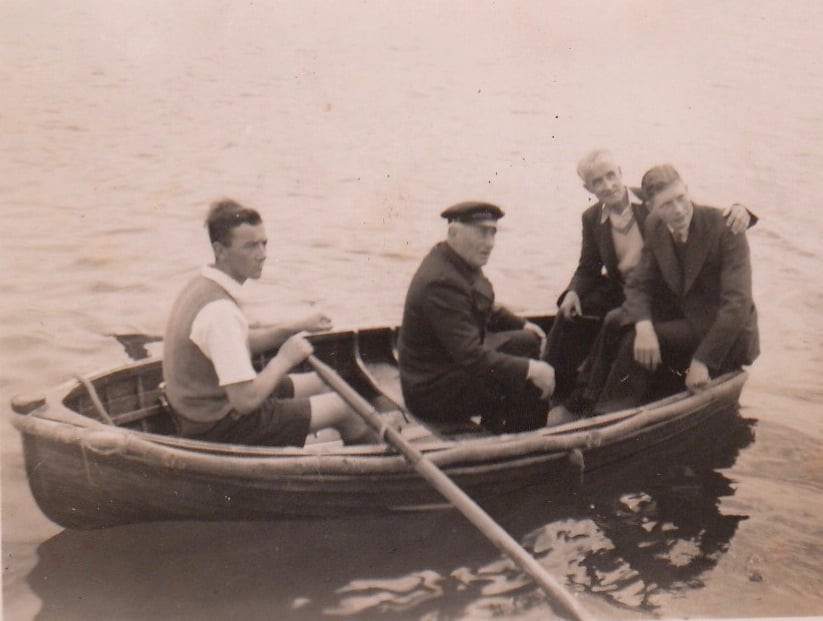
Neville Maguire in 1945, rowing the Mavis dinghy in Schull, with Skipper Kearney amidships.
To work properly, these little dinghies had to be miniature masterpieces, and in re-creating the 10ft Asgard dinghy, Larry Archer had the devil's own job in getting the planking to take on the required twist in under the transom in order to match Colin Archers tightly turned lines, which enabled the little boat to carry weight, yet tow easily and lightly when unladen. In fact, he reckons that the original must have been built with a supple newly-felled tree, whereas he was working with timber left over from the Asgard conservation, and there was one split plank before they got it right for a very fine job.
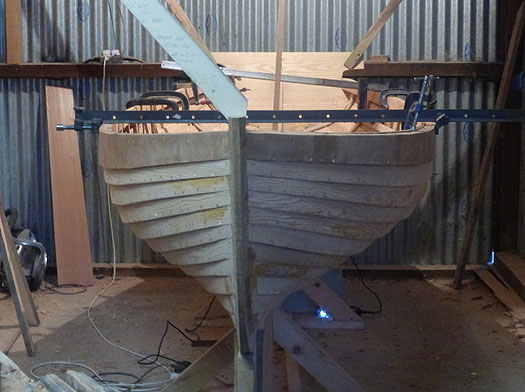
The Colin Archer-designed Asgard dinghy has a particularly elegant shape Photo: W M Nixon

As the Asgard dinghy nears completion, the tight turn to the planking under the transom is clearly seen. Photo: Pat Murphy
The boat wasn't designed with a centreplate, but she carried a little lugsail, and a rudder was fitted. Anyone who has ever sailed a clinker dinghy with the plate up will know that, from a standing start, she'll simply sail sideways. But if you get forward way built up, it's surprising how well the bit of lateral resistance provided by the rudder and the small amount of immersed hull enables you to make better to windward than just a beam reach, allowing all sorts of attractive little sailing options when the mothership is at rest in a pleasant anchorage. And if you do need to make real progress dead into the wind, she rows a treat.
Windward work will be no problem at all with the new City One dinghies from Limerick. Looking at the workmanlike lines drawn by Theo Rye, who got to know Gary MacMahon of the Ilen Trust when they were working together in the Peggy Bawn publishing team producing the massive history of the work of designer G L Watson, the analogy that springs to mind regarding windward work by the City One is "Rat up a Drainpipe".
Construction under way in Limerick on the first City One. Photo: Gary MacMahon
The emerging hull shape, designed for speed. Photo: Gary MacMahon. Photo: Gary MacMahon
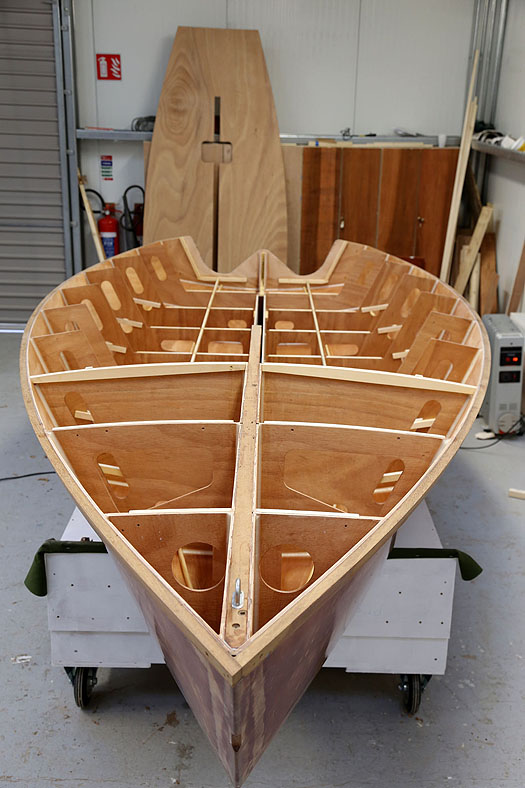
The City One is an impressive example of timber engineering. Photo Gary MacMahon
These will be potent performers, well able to hold up their heads in any race fleet, and it has been a flash of inspiration by the Ilen team to go for this type of boat rather than some sort of conservative option which would provide a maximum number of berths afloat, but a rather dull sailing experience.
By working in wood with the epoxy technique, they're getting the best of both worlds. But the Ilen organisation spreads its tentacles widely, and another of their wooden boat-building project is the re-creation of the classic Shannon and Limerick gandelows, which evolved a flat-bottomed hull shape to be able slither across those acres of mud which are inevitable at low water in the estuary, as Limerick has the biggest tidal range in all Ireland.
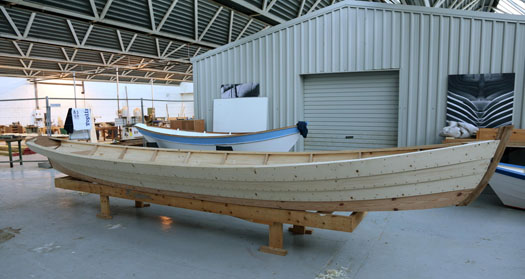
The revival of the traditional Shannon Gandelow is another Ilen Trust project. Photo: Gary MacMahon
Having been in the gondola-building boatyard on one of the Venetian islands (it's a marvellous old workshop, redolent with Stockholm tar and the aromas of fine timber), I have to concede that the Limerick gandelows are only a very distant relation of the classic Venetian originals from which they presumably derived their name. But the international brotherhood of traditional boatbuilding is strong, and the Limerick team will be taking their unusual craft to Venice on 30th April this year for racing displays.

Limerick's Liam O'Donoghue is one of those contemplating the prospect of Shannon gandelows going to Venice to link up with local gondolas. Photo: Gary MacMahon
Meanwhile in Bray so many have been involved with the truly community-wide project to re-create the Droleen class that it might be unfair to single out any one individual, but the popular Barracuda restaurant (it's above the Aquarium on the seafront south of the harbour) has been hugely supportive of a project which has already seen the first boat sailing.
She sets a fascinating rig slightly reminiscent of the setup on the first 1887 double-ended Water Wags. But where the Wags had a standing lug, the Droleens are gunter lug, with the foot of the gaff boom attached to a jaws which slides up and down the mast. Yet that startling spinnaker/jib matches the style of the original Wags, and it anticipates more modern concepts in that, in light airs at any rate, if you keep the spinnaker boom in line with main boom, you can continue to carry the "frontsail" with the wind well forward of the beam.
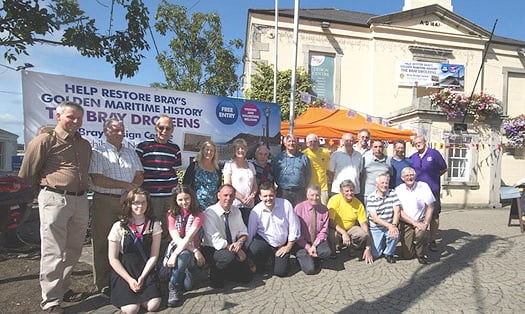
The community group involved with reviving the Droleen class. The first boat will be taking part in Bray's St Patrick's Day Parade.
In the urgency to get the boat sailing before the season had faded away completely, they got a temporary suit of sails stitched up by the fabric shop in Bray's main street, but we're assured that for the season of 2014 they'll have a grown-up suit of sails from noted local sailmaker Harry Sterling. Maybe so, but well done to the fabric shop, their temporary suit looks very well indeed, and the colour is just right to suggest cotton sails of the 1890s.

The new Droleen sailing in Bray Harbour.
The fact that this re-born design has also proven to be an ideal little workboat in on one of the rocky inlets of Connemara is yet another twist in a tale which clearly has legs. And yes, I'm well aware that there are several other wooden boatbuilders in Ireland producing interesting classic and traditional craft each in their own special way. But for now, the Asgard dinghy, the City One performance sailer, the Limerick Gandelow, and the Bray Droleen have given us more than enough to be going along with.
New Year Currachs to be Launched on the Liffey
#CURRACH – Two traditional Irish currachs are being built on the banks of the river Liffey and will be afloat on the Irish sea in the first week of the new year. The special project undertaken by East Wall Sports Club aims to highlight the ancient Irish craft of boat building.
The launch at the Club on January 7th follows a month-long currach workshop where a team have been hand-building the boats under the careful guidance of artist and boat-builder, Mark Redden, who learnt the craft from Jackie Mons and Cork currach builder Padraig O Duinnin.
Mark told 98fm radio the currach represents more than a simple water craft: “It stands for the quality of ancient design, a legacy left to us by our forbearers and a resourcefulness applicable to today’s life. We’re drawing on all of this to build two Connemara curachs by the 7th of January!”
It is hoped these new additions in Dublin’s currach fleet will produce crews that will compete in the regattas of the west coast. Des Moriarty one of the original team and photographer for the project continued “the launch will mark 2012 as the year of the currach and the team and club welcome everyone with an interest to come on the 7th, see them launch into the Irish sea hear more about the build and project from Mark and off course enjoy some great food and music!”
More on this story from 98fm here and Dublin People here. The East Wall Sports Club facebook page is here
Limerick to Host New Boatbuilding Degree Courses
A new scheme to teach traditional boatbuilding skills to university level could be of huge benefit to young people from disadvantaged areas of Limerick.
The Irish Times reports that degree programmes in traditional boat craft accredited by the UK's University of Middlesex are set to take their first students in 2012.
Minister for the Marine Simon Coveney also confirmed that partnerships have been developed with the US Northwest School of Wooden Boat-building and Sail Training International.
Some 40 trainees, mostly from Limerick's designated regeneration areas, have already taken part in the restoration of the ketch Ilen, designed by record-breaking sailor Conor O'Brien.
The AKA Ilen project, set up by boat-builder Gary McMahon, is intended to "nurture self-belief and confidence through the medium of wooden boatbuilding and maritime education".
The Irish Times has more on the story HERE.
Tributes Paid to Cork Boat Builder George Bushe
Sailing tributes have been paid to legendary boat builder George Bushe, who died last week aged 89.
Born in Baltimore, Co Cork, Bushe got his start in boat building through his father, who make traditional punts. From there he went on to Skinner's Boatyard in Skibbereen and worked with the late Jack O'Driscoll in Ringaskiddy.
In the 1960s and '70s he worked at the Southcoast Boatyard in Rochestown, where be built many famous racing boats for Cork's premier sailing clans - such as the Golden Apple for the late Hugh Coveney, father of Minister for the Marine Simon Coveney.
Bushe went into semi-retirement in the 1970s, working at the Royal Cork Yacht Club, restoring boats in winter and even racing his own until the mid 2000s.
His remains were carried to St Patrick's Cemetary in Crosshaven aboard the Cánóg, the last boat he completed and which he raced competitively as recently as 2006.
George Bushe is survived by his wife Carmel and their children: Bernice, Fergus, sail maker Majella, shipwright Mark, and boat builder and sailor Killian Bushe, who just last month received the Fastnet Award for his own contributions to sailing.
The Irish Examiner has more on the story HERE.
































